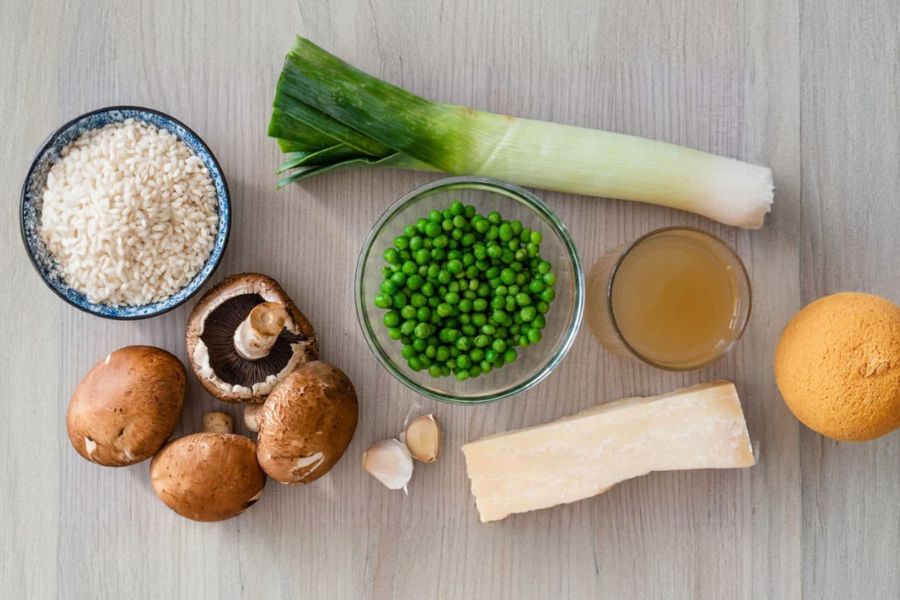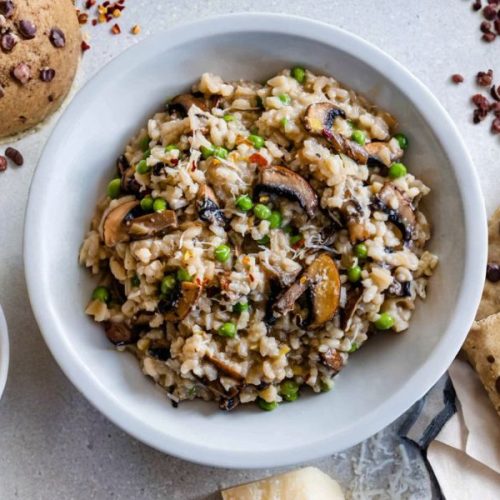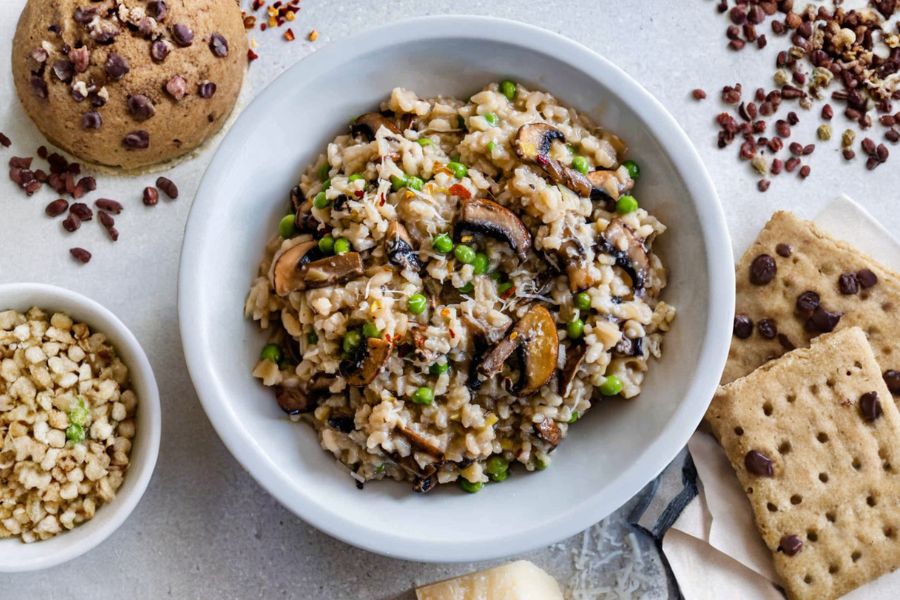This Mushroom and Pea Risotto transforms a classic Italian comfort dish into a quick, weeknight-friendly meal without compromising flavor or nutrition.
Creamy and satisfying, the risotto balances earthy mushrooms with sweet peas, offering a protein-rich, fiber-packed, and naturally vegetarian option.
Arborio rice provides slow-digesting carbohydrates, while olive oil and parmesan cheese contribute heart-healthy fats and essential nutrients.
The recipe is versatile—swap peas for spinach, kale, or asparagus for added vitamins and antioxidants. Its one-pan preparation keeps cleanup minimal, making it perfect for everyday cooking, meal prep, or cozy family dinners.

Rich in plant-based protein, low in saturated fat, and brimming with flavor, this dish proves that nutritious meals can be effortless, indulgent, and wholesome all at once.
Must-Have Tools for Perfect Results
Large Nonstick Skillet
Ideal for sautéing mushrooms, leeks, and garlic without sticking. Its even heat distribution ensures perfectly browned mushrooms and reduces cleanup time, making it indispensable for everyday cooking.
Ladle
Essential for gradually adding hot stock to the risotto, a ladle allows precise control over liquid incorporation, helping achieve the perfect creamy consistency every time.
Wooden Spoon
Perfect for stirring without scratching your cookware. Its sturdy design helps evenly distribute heat and mix ingredients gently, preventing the rice from sticking or breaking.
Microplane Grater
Perfect for finely grating parmesan cheese, ensuring it melts smoothly into the risotto. Beyond this recipe, it’s perfect for zesting citrus, grating garlic, or hard cheeses in any dish.
Measuring Cups & Spoons
Accurate measurements of rice, stock, and seasonings guarantee consistent results. They’re versatile tools for baking, sauces, and everyday cooking.

Creamy Mushroom and Pea Risotto
Equipment
- 1 Large Nonstick Skillet
- 1 ladle
- 1 Wooden Spoon
- 1 Microplane Grater
- 1 Measuring Cups & Spoons
Ingredients
- 400 g / 14 oz mushrooms sliced
- 1 medium leek sliced
- 2 –3 garlic cloves diced
- 2 –3 tbsp olive oil
- 1 ½ cups arborio rice
- ½ cup dry white wine
- 6 ½ cups vegetable stock heated
- 50 g / 2 oz parmesan cheese finely grated
- 1 cup frozen green peas
- Salt and cracked black pepper to taste
- Red pepper flakes optional
Instructions
- Sauté the Mushrooms: Heat 2 tablespoons of olive oil in a large nonstick skillet over high heat until shimmering, then add the sliced mushrooms. Cook them undisturbed for 3–4 minutes to allow browning, then stir occasionally until all pieces are golden and slightly caramelized. Season lightly with salt and black pepper, remove from the skillet, and set aside to preserve their flavor and texture.
- Cook the Leek and Garlic: In the same skillet, add the remaining tablespoon of olive oil and the sliced leek. Sauté over medium heat for 3–5 minutes until soft and fragrant, then add the diced garlic. Stir continuously to prevent burning, letting the aromas blend and release their natural sweetness into the pan.
- Toast the Arborio Rice: Reduce heat to medium, add the arborio rice to the leek and garlic mixture, and stir well. Cook for 2–3 minutes, allowing the rice to toast slightly and absorb the oil, which enhances its nutty flavor and prepares it to absorb the liquid evenly.
- Deglaze with White Wine: Pour in the dry white wine, stirring constantly until the liquid mostly evaporates. This step lifts any browned bits from the pan, adding a subtle tangy depth that balances the creaminess of the risotto.
- Gradually Add Vegetable Stock: Begin adding the heated vegetable stock one ladle at a time, stirring gently but continuously. Wait until most of the liquid is absorbed before adding the next ladle, repeating this process for about 15 minutes until the rice is creamy, tender, and slightly al dente.
- Incorporate Parmesan Cheese: Once the rice is nearly cooked, grate in the parmesan cheese and stir with a ladle of stock to melt it fully, creating a rich, silky texture that coats each grain of rice perfectly.
- Add Peas and Mushrooms: Fold in the frozen peas and the sautéed mushrooms, cooking for an additional 1–2 minutes until the peas are tender and the mushrooms are heated through. Taste and adjust seasoning with salt and cracked black pepper as needed.
- Serve and Garnish: Transfer the risotto to serving bowls, finishing with extra grated parmesan, a sprinkle of red pepper flakes if desired, and freshly cracked black pepper. Serve immediately for the best creamy texture and full flavor experience.
Notes
- Use high-quality arborio rice for the creamiest texture; avoid long-grain rice, which won’t release enough starch.
- Always keep your vegetable stock hot to maintain consistent cooking temperature and reduce cooking time.
- Do not rush adding the stock—adding it gradually is key to achieving a smooth, creamy risotto.
- Sauté mushrooms on high heat without salt initially to prevent excess water and achieve deep browning.
- Leftovers can be gently reheated with a splash of stock or water to restore creaminess.
- Customize vegetables—spinach, kale, or asparagus work beautifully as alternatives to peas.
- Finish with fresh parmesan rather than pre-grated for a richer, melt-in-your-mouth flavor.
Chef’s Secrets For Creamy Risotto
The secret to a perfect risotto lies in patience and attention to heat.
Toasting the rice before adding liquid enhances its nutty flavor, while gradually adding hot stock ensures each grain absorbs liquid evenly, creating a creamy consistency without becoming mushy.
Using high-quality olive oil and fresh parmesan cheese elevates both flavor and texture.
When sautéing mushrooms, resist the urge to stir constantly—allow them to brown undisturbed to maximize umami depth.
Tasting frequently is crucial; risotto should be tender but slightly al dente at the finish. Small adjustments like adding a touch of lemon juice or seasoning incrementally can bring the dish to perfection.
Serving Suggestions For Best Experience
Serve this risotto piping hot with an extra sprinkle of parmesan and a dash of red pepper flakes for a hint of spice.
Pair with a crisp green salad or roasted seasonal vegetables for a complete, balanced meal.
For wine lovers, a light Pinot Grigio or Sauvignon Blanc complements the earthy mushrooms and creamy rice beautifully.
This dish also works well as a side to roasted chicken or grilled fish, offering a comforting, versatile base.
For meal prep, portion into airtight containers and top with fresh herbs just before serving to retain aroma and vibrancy.
Storage Tips For Long Freshness
Store leftover risotto in an airtight container in the refrigerator for up to 3 days.
To maintain its creamy texture when reheating, add a splash of hot vegetable stock or water and gently warm over low heat, stirring occasionally.
Risotto can also be frozen, though it is best consumed within 1 month.
Thaw overnight in the refrigerator, then reheat slowly to preserve texture. Avoid overheating in the microwave, as this can make the rice dry or mushy.
Labeling containers with the date ensures freshness and prevents waste.
Frequently Asked Questions Answered Clearly
1. Can I make this recipe vegan?
Absolutely! Simply swap parmesan cheese for plant-based parmesan or nutritional yeast to maintain the cheesy flavor. Olive oil remains the main fat source, keeping the dish creamy and rich.
2. Can I use different mushrooms?
Yes. Cremini, shiitake, or portobello mushrooms all work well. Just ensure they are sliced evenly to cook consistently and achieve a rich, earthy flavor.
3. How do I know when risotto is done?
The rice should be tender but slightly firm at the center, with a creamy consistency. Taste frequently toward the end of cooking and adjust with extra stock if necessary.
4. Can I prepare this ahead of time?
You can prep the mushrooms, leek, and stock in advance, but for best results, cook the risotto fresh. Leftovers can be stored and reheated gently for up to 3 days.
5. Can I substitute wine in the recipe?
Yes, if you prefer a non-alcoholic version, use a squeeze of lemon juice or a light vegetable broth to deglaze the rice. The flavor remains balanced and tangy.
This recipe has been adapted and simplified from the original version by cookingwithayeh. We’ve refined the steps for a smoother cooking experience and added helpful notes, nutrition insights, and essential kitchen tools to make it even easier for home cooks.

